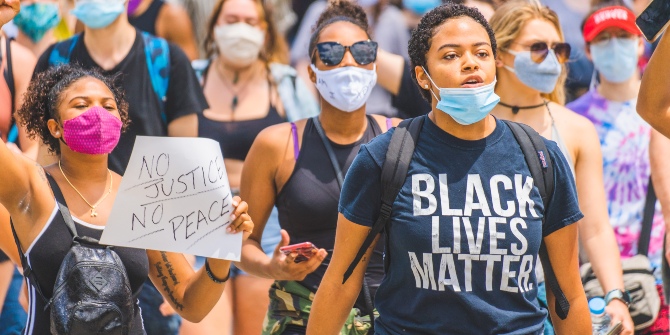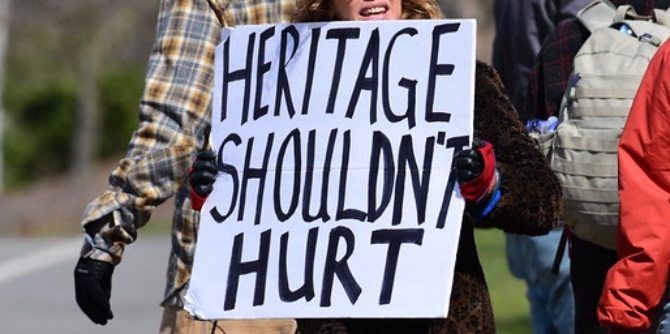 The death of George Floyd while being arrested by police in Minneapolis, Minnesota has led to a renewed wave of #BlackLivesMatter protests both in the US and across the world. Clive James Nwonka looks at why these protests are different this time, how social media have allowed them to spread across the world, and the limitations of film and cultural texts to address racism in society.
The death of George Floyd while being arrested by police in Minneapolis, Minnesota has led to a renewed wave of #BlackLivesMatter protests both in the US and across the world. Clive James Nwonka looks at why these protests are different this time, how social media have allowed them to spread across the world, and the limitations of film and cultural texts to address racism in society.
We’ve seen protests before linked to police related killings, like in Ferguson, Missouri, in 2014. Are these protests different this time, and if so how?
What we are seeing is the cumulative impact of a number of unaddressed racial injustices in America over a number of years. Yes, there has been a long legacy and history of police violence, brutality and the killing of black men and women, and that the greatest public mobility against racism for a generation as witnessed in the #BlackLivesMatter movement was born during the Obama presidency speaks to the inability of consecutive Governments to address racial injustice through legislation. What is different here is the visceral nature of the images of the killing.
The images show what we understand about the fatal relationship between black people and the police in the US, but George Floyd’s cries of ‘I can’t breathe’ are also a metaphor for the racial injustices experienced in every sphere of the American body social. So the unprecedented nature of the protests have been ignited by the killing of George Floyd, but is also referring to racial injustice in the labour market, the economy, in education, in institutions and the workplace, the judiciary and the US penal system, healthcare and the disproportionate number of COVID-19 deaths amongst African Americans, and of course, the encouraged rise of the alt-right and white supremacy. Sadly, as always, black death seems to be the prerequisite for a national conversation about systemic racism.
How has social media changed the way modern movements like #BlackLivesMatter work to achieve change compared to movements in the past?
It is definitely true that the art of black anti-racist protest was not created in Silicon Valley, but what social media platforms have enabled is the rapid uptake and circulation of images, videos and narratives of racial injustice, and allowed for amazing forms of viral mobilisation and organisation. On the one hand, videos such as the killing of George Floyd become forms of documentation, citation and evidence, and so much of the anti-racist agenda, sadly, has placed a burden on black people to prove racial injustice. Social media is now enabling that in ways that were not possible previously. Secondly, it has allowed us to galvanise people across the world, as we are seeing with #BlackLivesMatter, and given us the ability to respond en masse within a matter of hours. This is the triumph of platforms such as Twitter and Instagram.
How can media and film address structural racism in institutions like the police, and in wider society at large?
There is always the risk of placing too much a burden on the ability of film and cultural texts to address racism within society. I think we have to apply some caution and care to the degree of expectancy that we have, and will place on film, media, and culture to respond and address racism in both US and UK contexts. Film and media is a powerful form of education and consciousness raising, and we have seen so many films that have attempted to represent racial injustice and struggle in America. We have seen over the last few days the celebration, exchange and circulation of film, literature and media that responds to the black condition as a way of making sense of the last few days. But the appreciation of black cultural products in the mainstream is always temporary, and often follows moments of racial tragedy in the public arena.
But the issue is also authorship; who is making these film and media products, how is that authorship connected to the racial message it is trying to convey, and who is the audience? The ability of film and culture to be a tool of anti-racism will be determined by the willingness of the mainstream to value them beyond this moment of protest.
- “2020.06.03 Protesting the Murder of George Floyd, Washington, DC USA 155 50240” by Ted Eytan is licensed under CC BY SA 2.0
- On Friday 12 June 2020, from 4:00pm to 5:30pm (BST) the LSE US Centre will be hosting the online roundtable discussion, Race and Policing in America with Professor Tracey L. Meares, the Walton Hale Hamilton Professor and a Founding Director of the Justice Collaboratory at Yale Law School. More information and how to attend.
Please read our comments policy before commenting.
Note: This article gives the views of the authors, and not the position of USAPP – American Politics and Policy, nor the London School of Economics.
Shortened URL for this post: https://bit.ly/2Afdkwv
About the author
 Clive James Nwonka – LSE Sociology
Clive James Nwonka – LSE Sociology
Dr Clive James Nwonka is an LSE Fellow in Film Studies within the Department of Sociology. His research is situated at the intersections of contemporary realism and film policy, with particular interests in black British film, international cinemas and American Independent film.






